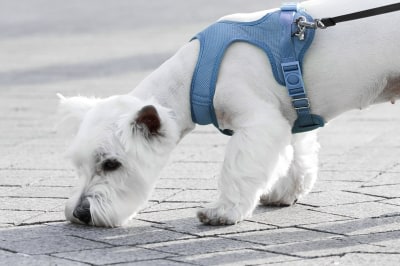Figuring out how to get a scared or anxious cat or dog to the vet can be challenging. Cats clawing and scratching when you're trying to put them in their carriers, dogs whining in the car, and dogs yelping and whining in the waiting room are just some of the stressors. Today, our vets in Oklahoma City share tips for how to get anxious dogs and cats to the vet.
Stress harms pets' physical and mental health, and it can cause your cat or dog to become traumatized after their vet visit. A pet's stress can also cause test results to be skewed and weaken the immune system. Reversing anxiety in pets can be difficult, but the steps below can help calm your four legged-friend’s fears.
Practice Handling Your Pet
Veterinarians sometimes face significant challenges in handling pets' feet and ears, as many pets are not comfortable with these body parts being touched. However, even pets adopted later in life can be conditioned to accept handling, grooming, and restraint.
To create a positive association with handling these areas, it’s important to pair potentially unpleasant tasks with delicious, high-value treats. Training your dog to give you a paw for nail trims or focus on a treat while cleaning their ears can help reduce fear and struggle.
Distraction with high-value treats, praise, and petting can keep pets occupied during unpleasant tasks, but conditioning them to realize good things come from handling can significantly reduce fear and anxiety.
Schedule Appointments Early
Your vet’s office may become busier during the day. Routine appointments can run long, emergencies may be squeezed in, and sometimes you and your pet could end up waiting in a packed waiting room before being shown to a quiet exam room.
See if you can get the earliest time slot when you schedule your pet’s appointment. This can help avoid the chaos of a packed waiting room. If this just isn’t possible, call the veterinary office when you arrive to find out if you and your pet can wait outside or in the car until there is an exam room available.
Get Your Cat Used to the Carrier
Your cat's carrier should be a friend, not a foe. Unfortunately, most cats only see the carrier when they are about to go to the vet. This creates a negative association, and so it's no wonder your cat bites and scratches while you're trying to put them inside.
To avoid this, try leaving the carrier out at all times so your cat can go in and out as they please. Throw in some snacks so that your cat creates a positive association with it. You can even line the carrier with a soft blanket, a toy or two, and a scent your cat enjoys to make traveling less stressful for your pet.
Should I feed my cat before the vet?
As a side note, it might be a good idea to not feed your cat before their vet visit. This will make them more receptive to treats, or just normal food, for staying calm and relaxed during their checkup .
Calm Yourself First, Then Calm Your Pet
When trying to calm your pet, it is important to first calm yourself. Cats and dogs are highly sensitive to human emotions, so if you’re feeling anxious or stressed, your pet may pick up on those feelings and become more agitated.
Take a few deep breaths, find a quiet space, and focus on calming your own mind before attempting to soothe your pet. Once you’re calm, you can then approach your pet with gentleness and reassurance, using soft tones and slow movements.
Tire Your Pet Before the Visit
Tiring your pet before a visit to the veterinarian can help reduce their anxiety and make the experience less stressful for both of you. Engaging in physical activities such as playing fetch or going for a long walk can help burn off excess energy and make them calmer during the appointment.
Additionally, mental stimulation activities like obedience training or playing with puzzle toys can also help tire your pet and keep their mind occupied. By combining physical and mental exercises, you can make sure your pet is more relaxed before the visit to the vet.
Ask Your Veterinarian for Help
Despite our best efforts, pets are sometimes just too stressed or anxious while they are visiting the vet. In these cases, anti-anxiety medication or a mild sedative can help. These can help calm your pet and make the vet visit less distressing for them. However, it's always important to consult your veterinarian first before giving your pet any kind of medication. The veterinarian can recommend the proper dosage to ensure your pet's safety.
Dog & Cat Behavior After a Vet Visit
After a vet visit, it’s common for both cats and dogs to exhibit changes in behavior. Some pets may become more withdrawn or anxious, while others may display increased restlessness.
These behavioral changes can be attributed to the stress and discomfort associated with the visit. It is important to provide a calm and comforting environment for your pet during this time, allowing them to readjust and recover at their own pace.
Note: The advice provided in this post is intended for informational purposes and does not constitute medical advice regarding pets. For an accurate diagnosis of your pet's condition, please make an appointment with your vet.



